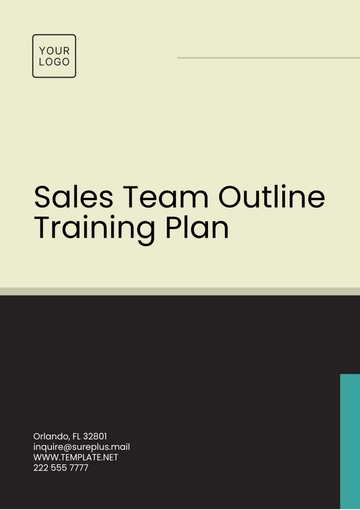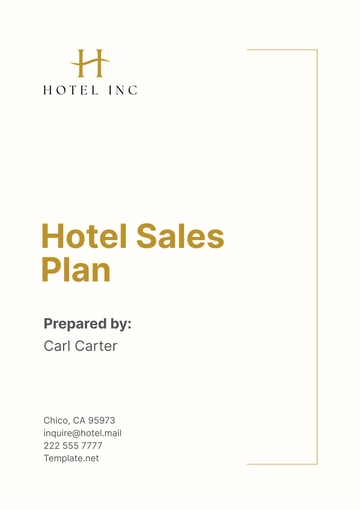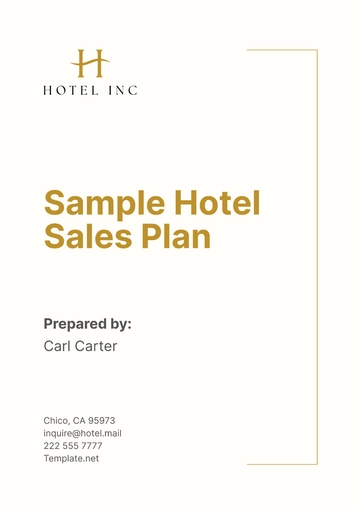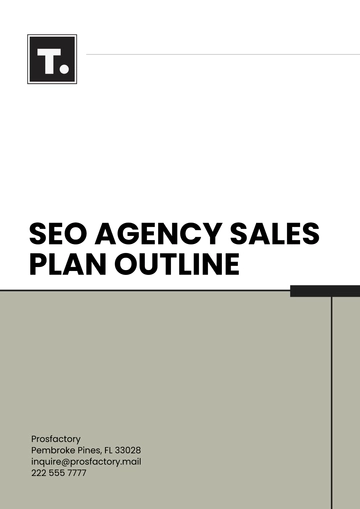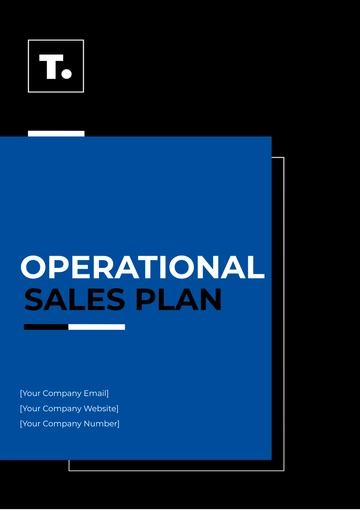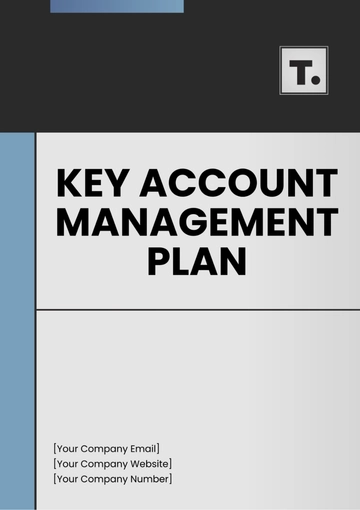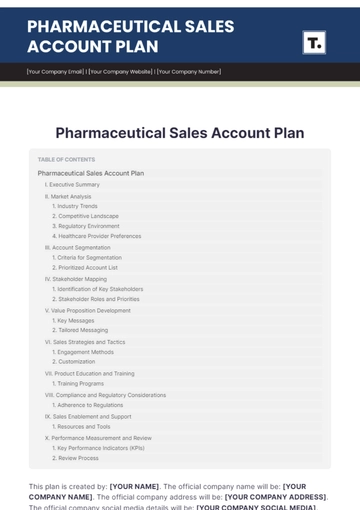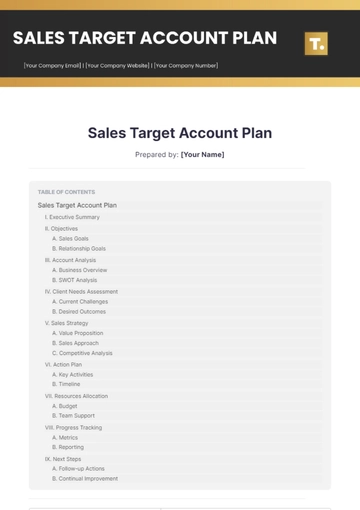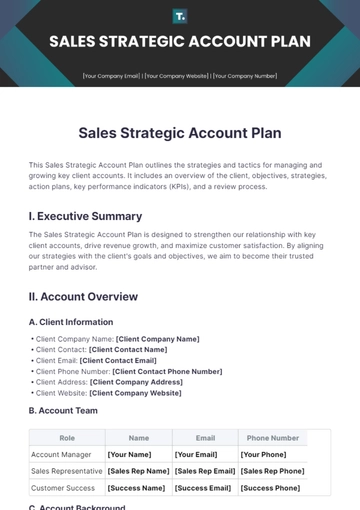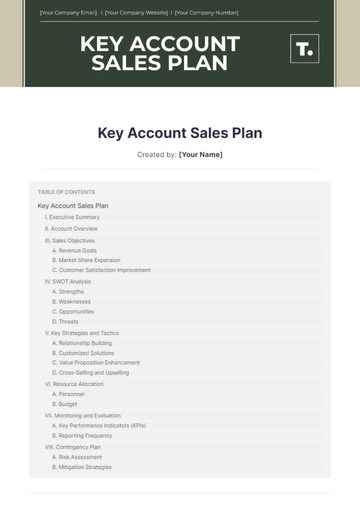Free Sales Commission Plan
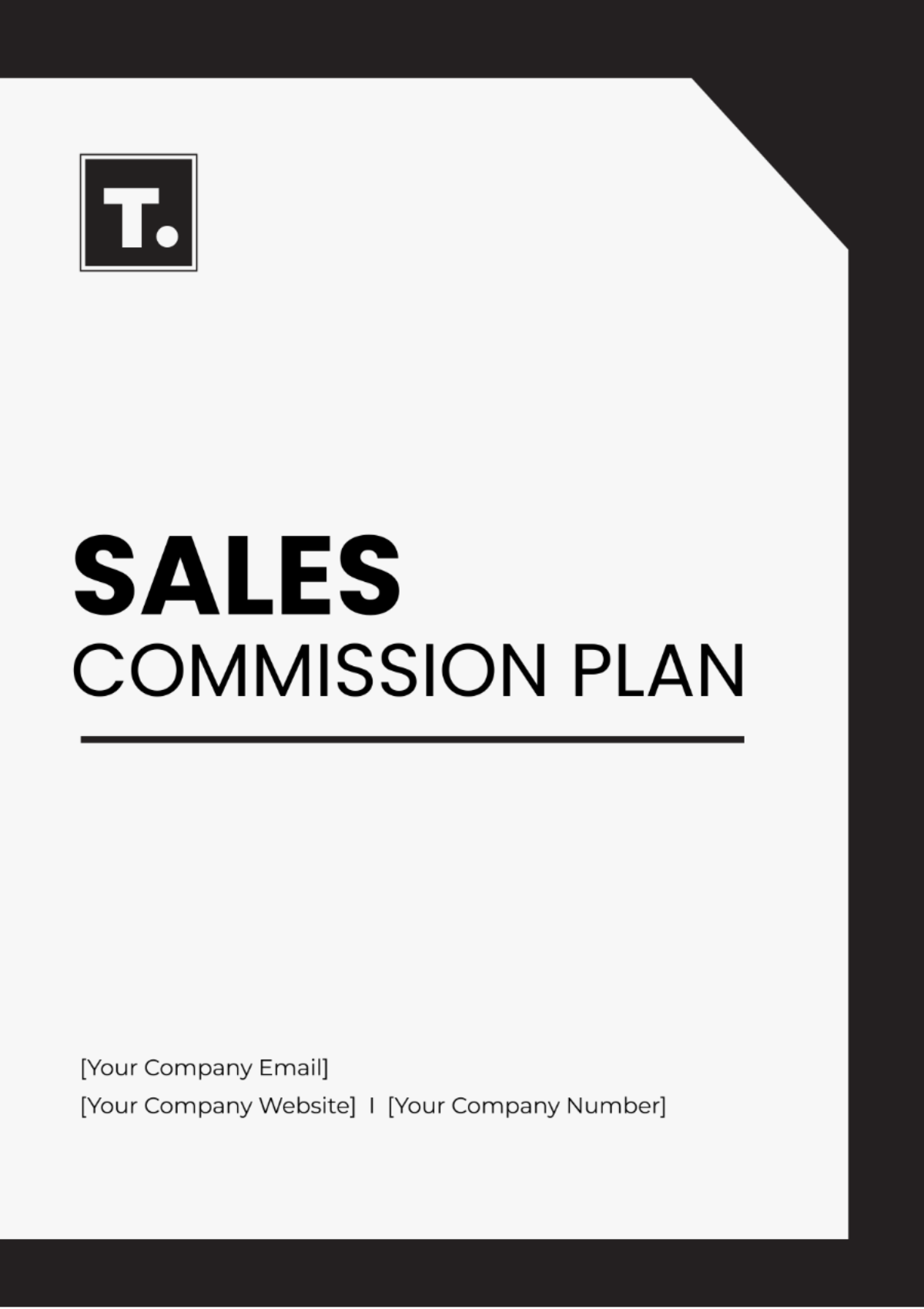
Written by: [Your Name]
I. Executive Summary
This Sales Plan aims to enhance the existing Sales Commission strategy at [Your Company Name]. By leveraging detailed market analysis, clear goals, and effective strategies, we aim to drive higher sales performance and increase revenue. [Your Company Name] will achieve this through a combination of actionable tactics, an adaptable framework, and well-allocated resources.
II. Goals
A. Short-Term Goals
Improve monthly sales by 15% within the next 6 months.
Increase average deal size by 10% by the next quarter.
Enhance sales team productivity by 20% through targeted training programs.
B. Long-Term Goals
Establish [Your Company Name] as the market leader within 2 years.
Expand the client base by 30% over the next 3 years.
Maintain a customer satisfaction rate of at least 95%.
III. Market Analysis
A. Market Overview
The target market for [Your Company Name] includes mid-sized enterprises in the [Specific Industry] sector. This market is projected to grow by 8% annually, presenting significant opportunities for expansion.
B. Competitive Landscape
[Your Company Name] competes with several key players, including [Competitor A], [Competitor B], and [Competitor C]. Our competitive advantage lies in our innovative products, customer-centric approach, and highly skilled sales team.
C. SWOT Analysis
Strengths | Weaknesses |
|---|---|
|
|
Opportunities | Threats |
|
|
IV. Strategic Approach
A. Sales Strategies
Tiered Commission Structure:
Motivate your sales team with a tiered commission system that rewards high performance and fosters healthy competition.
Data-Driven Tactics:
Harness the power of data analytics to pinpoint lucrative opportunities and tailor your sales approach for maximum impact.
Personalized Pitches:
Craft tailored sales pitches that resonate with individual client needs, demonstrating a deep understanding of their challenges and offering solutions.
B. Marketing Strategies
Targeted Digital Campaigns:
Boost brand visibility and engagement through precisely targeted digital marketing initiatives, optimizing reach and ROI.
Industry Webinars and Events:
Establish thought leadership and generate leads by hosting insightful webinars and industry events that showcase your expertise and provide value to attendees.
CRM Nurturing:
Strengthen client relationships with a comprehensive CRM system that tracks interactions, anticipates needs, and facilitates personalized communication and follow-up.
V. Actionable Tactics
A. Sales Training
Continuous Learning: Offer ongoing training sessions to ensure your sales team stays abreast of evolving sales methodologies, product advancements, and customer engagement tactics.
Interactive Workshops: Engage your team with interactive workshops that facilitate hands-on learning experiences, role-playing scenarios, and peer-to-peer knowledge sharing.
B. Incentive Programs
Dynamic Rewards: Implement versatile incentive programs that include not only monetary rewards but also recognition, career advancement opportunities, and desirable perks tailored to individual preferences.
Goal Alignment: Align incentive structures with strategic objectives to channel the sales team's efforts toward achieving key performance metrics and organizational goals effectively.
VI. Sales Team Structure
Team Role | Responsibilities |
|---|---|
Sales Manager | Oversee sales operations, set targets, and manage the sales team. |
Account Executives | Handle client relations, negotiate deals, and close sales. |
Business Development Representatives | Identify potential leads and secure initial meetings and presentations. |
Sales Support | Provide administrative and logistical support to the sales team. |
VII. Performance Metrics
Performance will be measured using the following key metrics:
Sales Targets Achievement:
Monitoring monthly and quarterly sales targets provides insight into the team's ability to meet revenue goals and drive business growth.
Lead Conversion Rates:
Evaluating conversion rates from leads to customers helps assess the effectiveness of our sales strategies in turning potential prospects into paying clients.
Customer Retention and Satisfaction:
Tracking customer retention rates and satisfaction levels allows us to measure our ability to retain clients and deliver exceptional service, fostering long-term relationships and loyalty.
Average Deal Size and Sales Cycle:
Analyzing the average deal size and sales cycle length provides valuable insights into sales efficiency and effectiveness, helping us optimize processes and resource allocation for maximum impact.
VIII. Adaptability Strategies
A. Continuous Improvement
Data-Driven Iteration: Continuously monitor performance metrics, leveraging data insights to iteratively refine and enhance sales strategies for optimal effectiveness and adaptability.
Agile Strategy Adjustment: Adopt an agile approach to strategy refinement, swiftly adjusting tactics based on real-time feedback and emerging trends to stay ahead of the curve.
B. Market Trends
Proactive Industry Monitoring: Proactively monitor industry trends and competitor activities through robust market research and analysis, enabling proactive adaptation to evolving market dynamics.
Strategic Agility: Cultivate organizational agility to quickly respond to changing market conditions, leveraging insights on emerging trends to capitalize on new opportunities and mitigate potential threats.
IX. Resource Allocation
A. Budget
Strategic Allocation: Implement a comprehensive budgeting strategy that allocates funds strategically across sales training, marketing campaigns, sales tools, and commission payouts, ensuring optimal resource utilization and alignment with organizational goals.
Performance-Driven Budgeting: Utilize performance metrics to inform budget allocation decisions, prioritizing investments in areas that yield the highest return on investment and supporting sales team success.
B. Tools and Software
Cutting-Edge Technology: Invest in cutting-edge CRM systems, sales analytics tools, and communication platforms equipped with advanced features and capabilities to empower your sales team with the tools they need to thrive in today's competitive landscape.
Integrated Solutions: Prioritize integrated software solutions that streamline workflows and facilitate seamless collaboration, enabling your sales team to work more efficiently and effectively towards achieving their targets.
By following this comprehensive Sales Plan, [Your Company Name] aims to drive substantial growth and achieve long-term success in the competitive market landscape.
- 100% Customizable, free editor
- Access 1 Million+ Templates, photo’s & graphics
- Download or share as a template
- Click and replace photos, graphics, text, backgrounds
- Resize, crop, AI write & more
- Access advanced editor
Elevate your sales strategy with the Sales Commission Plan Template, offered by Template.net. This customizable resource empowers you to optimize your commission structure effortlessly. Downloadable and printable, it's designed for seamless integration into your workflow. What's more? It's editable in our AI Editor Tool, ensuring adaptability to your unique requirements.
You may also like
- Finance Plan
- Construction Plan
- Sales Plan
- Development Plan
- Career Plan
- Budget Plan
- HR Plan
- Education Plan
- Transition Plan
- Work Plan
- Training Plan
- Communication Plan
- Operation Plan
- Health And Safety Plan
- Strategy Plan
- Professional Development Plan
- Advertising Plan
- Risk Management Plan
- Restaurant Plan
- School Plan
- Nursing Home Patient Care Plan
- Nursing Care Plan
- Plan Event
- Startup Plan
- Social Media Plan
- Staffing Plan
- Annual Plan
- Content Plan
- Payment Plan
- Implementation Plan
- Hotel Plan
- Workout Plan
- Accounting Plan
- Campaign Plan
- Essay Plan
- 30 60 90 Day Plan
- Research Plan
- Recruitment Plan
- 90 Day Plan
- Quarterly Plan
- Emergency Plan
- 5 Year Plan
- Gym Plan
- Personal Plan
- IT and Software Plan
- Treatment Plan
- Real Estate Plan
- Law Firm Plan
- Healthcare Plan
- Improvement Plan
- Media Plan
- 5 Year Business Plan
- Learning Plan
- Marketing Campaign Plan
- Travel Agency Plan
- Cleaning Services Plan
- Interior Design Plan
- Performance Plan
- PR Plan
- Birth Plan
- Life Plan
- SEO Plan
- Disaster Recovery Plan
- Continuity Plan
- Launch Plan
- Legal Plan
- Behavior Plan
- Performance Improvement Plan
- Salon Plan
- Security Plan
- Security Management Plan
- Employee Development Plan
- Quality Plan
- Service Improvement Plan
- Growth Plan
- Incident Response Plan
- Basketball Plan
- Emergency Action Plan
- Product Launch Plan
- Spa Plan
- Employee Training Plan
- Data Analysis Plan
- Employee Action Plan
- Territory Plan
- Audit Plan
- Classroom Plan
- Activity Plan
- Parenting Plan
- Care Plan
- Project Execution Plan
- Exercise Plan
- Internship Plan
- Software Development Plan
- Continuous Improvement Plan
- Leave Plan
- 90 Day Sales Plan
- Advertising Agency Plan
- Employee Transition Plan
- Smart Action Plan
- Workplace Safety Plan
- Behavior Change Plan
- Contingency Plan
- Continuity of Operations Plan
- Health Plan
- Quality Control Plan
- Self Plan
- Sports Development Plan
- Change Management Plan
- Ecommerce Plan
- Personal Financial Plan
- Process Improvement Plan
- 30-60-90 Day Sales Plan
- Crisis Management Plan
- Engagement Plan
- Execution Plan
- Pandemic Plan
- Quality Assurance Plan
- Service Continuity Plan
- Agile Project Plan
- Fundraising Plan
- Job Transition Plan
- Asset Maintenance Plan
- Maintenance Plan
- Software Test Plan
- Staff Training and Development Plan
- 3 Year Plan
- Brand Activation Plan
- Release Plan
- Resource Plan
- Risk Mitigation Plan
- Teacher Plan
- 30 60 90 Day Plan for New Manager
- Food Safety Plan
- Food Truck Plan
- Hiring Plan
- Quality Management Plan
- Wellness Plan
- Behavior Intervention Plan
- Bonus Plan
- Investment Plan
- Maternity Leave Plan
- Pandemic Response Plan
- Succession Planning
- Coaching Plan
- Configuration Management Plan
- Remote Work Plan
- Self Care Plan
- Teaching Plan
- 100-Day Plan
- HACCP Plan
- Student Plan
- Sustainability Plan
- 30 60 90 Day Plan for Interview
- Access Plan
- Site Specific Safety Plan



